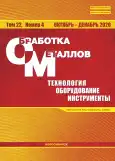Development and Research of a Profile Recorder for Measuring Deviations in the Shape of the Surface of Products by Laser Spiral Scanning
- Authors: Vasiliev S.A.1, Alekseev V.V.1, Vasiliev M.A.1, Fedorova A.A.1
-
Affiliations:
- Issue: Vol 22, No 4 (2020)
- Pages: 71-81
- Section: EQUIPMENT. INSTRUMENTS
- URL: https://bakhtiniada.ru/1994-6309/article/view/302005
- DOI: https://doi.org/10.17212/1994-6309-2020-22.4-71-81
- ID: 302005
Cite item
Full Text
Abstract
About the authors
S. A. Vasiliev
Email: vsa_21@mail.ru
D.Sc. (Engineering), Associate Professor, I. N. Ulianov Chuvash State University, 15 Moskovsky Prospekt, Cheboksary, 428015, Russian Federation, Vsa_21@mail.ru
V. V. Alekseev
Email: av77@list.ru
D.Sc. (Engineering), Associate Professor, I. N. Ulianov Chuvash State University, 15 Moskovsky Prospekt, Cheboksary, 428015, Russian Federation, av77@list.ru
M. A. Vasiliev
Email: mishawasilev@mail.ru
I. N. Ulianov Chuvash State University, 15 Moskovsky Prospekt, Cheboksary, 428015, Russian Federation, mishawasilev@mail.ru
A. A. Fedorova
Email: e_a_a@mail.ru
I. N. Ulianov Chuvash State University, 15 Moskovsky Prospekt, Cheboksary, 428015, Russian Federation, e_a_a@mail.ru
References
- Jeyapoovan T., Murugan M. Surface roughness classification using image processing // Measurement. – 2013. – Vol. 46, iss. 7. – P. 2065–2072. – doi: 10.1016/j.measurement.2013.03.014.
- Lushnikov N., Lushnikov P. Methods of assessment of accuracy of road surface roughness measurement with profilometer // Transportation Research Procedia. – 2017. – Vol. 20, pp. 425–429. – doi: 10.1016/j.trpro.2017.01.069.
- Non-contact surface roughness measurement of crankshaft journals using a super-continuum laser / V.V. Alexander, H. Deng, M.N. Islam, F.L. Terry // Conference on Lasers and Electro-Optics. – San Jose, 2010. – doi: 10.1364/CLEO_APPS.2010.AFA3.
- Babu R.A., Baldev R.A. Study of engineering surfaces using laser-scattering techniques // Sadhana. – 2003. – Vol. 28, pt. 3–4. – P. 739–761. – doi: 10.1007/BF02706457.
- Abidin F.Z., Hung J., Zahid1 M.N. Portable non-contact surface roughness measuring device // IOP Conference Series: Materials Science and Engineering. – 2019. – Vol. 469. – P. 012074. – doi: 10.1088/1757-899X/469/1/012074.
- Kiran R., Amarendra H.J., Lingappa S. Vision system in quality control automation // MATEC Web of Conferences. – 2018. – Vol. 144. – P. 03008. – doi: 10.1051/matecconf/201814403008.
- Shih F.Y. Image processing and pattern recognition: fundamentals and techniques. – Hoboken, NJ: Wiley, 2010. – 537 p. – ISBN: 978-0-470-40461-4.
- Lee B.Y., Tarng Y.S. Surface roughness inspection by computer vision in turning operations // International Journal of Machine tools and Manufacture. – 2001. – Vol. 41. – P. 1251–1263. – doi: 10.1016/S0890-6955(01)00023-2.
- Spagnoloa G.S., Cozzellaa L., Lecceseb F. Viability of an optoelectronic system for real time roughness // Measurement. – 2014. – Vol. 58. – P. 537–543.
- Measurement of surface roughness of metal using binary speckle image analysis / E. Kayahana, H. Oktemb, F. Hacizadeb, H. Nasibovb // Tribology International. – 2010. – Vol. 43. – P. 307–311. – doi: 10.1016/j.triboint.2009.06.010.
- Wang T., Groche P. Sheet metal profiles with variable height: numerical analyses on flexible roller beading // Journal of Manufacturing and Materials Processing. – 2019. – Vol. 3 (1). – P. 19. – doi: 10.3390/jmmp3010019.
- Stoudt M., Hubbard J.B. Analysis of deformation-induced surface morphologies in steel sheet // Acta Materialia. – 2005. – Vol. 53 (16). – P. 4293–4304. – doi: 10.1016/j.actamat.2005.05.038.
- Васильев С.А., Максимов И.И., Алексеев В.В. Методика и устройство для профилирования поверхности почвы и определения направления стока атмосферных осадков в полевых условиях // Вестник АПК Ставрополья. – 2015. – № 3 – С. 22–26.
- Васильев С.А., Алексеев В.В., Речнов А.В. Экспресс-метод количественной оценки пожнивных остатков на поверхности почвы // Аграрный научный журнал. – 2015. – № 9. – С. 11–13.
- Hockauf R., Grove T., Denkena B. Prediction of ground surfaces by using the actual tool topography // Journal of Manufacturing and Materials Processing. – 2019. – Vol. 3 (2). – P. 40. – doi: 10.3390/jmmp3020040.
- Vasiliev S., Kirillov A., Afanasieva I. Method for controlling meliorative technologies on sloping cultivated lands using large scale profilometer // Engineering for Rural Development. Proceedings. – 2018. – Vol. 17. – P. 537–542.
- Васильев С.А. Разработка метода и профилографа для оценки мелиоративных технологий на склоновых агроландшафтах // Известия Нижневолжского агроуниверситетского комплекса: наука и высшее профессиональное образование. – 2016. – № 3. – С. 220–226.
- Васильев С.А. Обоснование конструктивно-технологических параметров профилографов для контроля мелиоративных технологий на склоновых агроландшафтах // Научный журнал Российского НИИ проблем мелиорации. – 2016. – № 4. – С. 40–54.
- Image-based inspection technique of a machined metal surface for an unmanned lapping process / D. Ravimal, H. Kim, D. Koh, J.H. Hong, S.K. Lee // International Journal of Precision Engineering and Manufacturing-Green Technology. – 2019. – doi: 10.1007/s40684-019-00181-7.
- Application of laser profilometry to evaluation of the surface of the workpiece machined by abrasive water jet technology / G. Mital, J. Dobránsky, J. Ruzbarský, Š. Olejárová // Applied Sciences. – 2019. – Vol. 9. – P. 21–34. – doi: 10.3390/app9102134.
- Liu C.-Y., Tzu-Ping Y. Digital multi-step phase-shifting profilometry for three-dimensional ballscrew surface imaging // Optics and Laser Technology. – 2015. – Vol. 79. – P. 115–123. – doi: 10.1016/j.optlastec.2015.12.001.
- Bracun D., Perdan B., Diaci J. Surface defect detection on power transmission belts using laser profilometry // Strojniški vestnik – Journal of Mechanical Engineering. – 2011. – Vol. 57 (3). – P. 257–266. – doi: 10.5545/sv-jme.2010.176.
- Campana C., Moslehpour S. Non contact surface roughness measurement instrumentation // American Society for Engineering Education. – 2007. – AC 2007-2557. – P. 12.1107.
- Development and verification of a one-step-model for the design of flexible roll formed parts / P. Groche, A. Zettler, S. Berner, G. Schneider // International Journal of Material Forming. – 2010. – Vol. 4 (4). – doi: 10.1007/s12289-010-0998-3.
- Schilling R.J. Fundamentals of robotics: analysis and control. – New Delhi: Prentice Hall, 2005. – ISBN 81-203-1047-0.
Supplementary files






